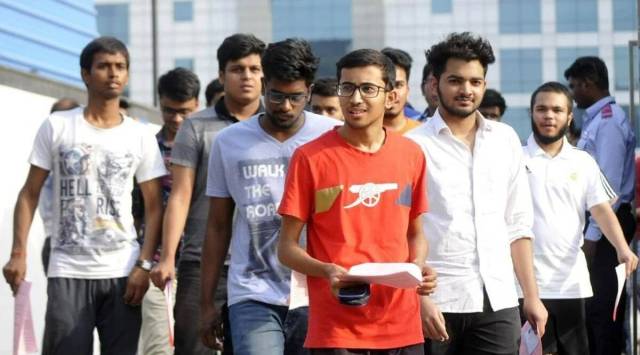In 6 years, special loans for higher education at one-third of target
In an official statement shared with The Indian Express, the Union Ministry of Education attributed the shortfall to Covid-19, which broke out in 2020, and a revision in the funding pattern during the same year.
 In 2018-19, as many as 48 loans worth Rs 15,572.56 crore were sanctioned, thereby missing the first annual target.
In 2018-19, as many as 48 loans worth Rs 15,572.56 crore were sanctioned, thereby missing the first annual target. The Higher Education Financing Agency (HEFA), which was set up by the Centre in 2017 to upgrade the education infrastructure in the country to global best standards, has sanctioned 144 loans worth Rs 35,000 crore so far, falling short of the government’s target of mobilising Rs 1 lakh crore by 2022, according to information obtained by The Indian Express through an RTI application.
HEFA, which was set up as a non-profit Non-Banking Financing Company (NBFC), is a joint venture between the Union Ministry of Education and the Canara Bank to finance infrastructure development in educational institutions through long-term loans.

In an official statement shared with The Indian Express, the Union Ministry of Education attributed the shortfall to Covid-19, which broke out in 2020, and a revision in the funding pattern during the same year.
During the launch of the RISE scheme on July 5, 2018, then Union Education Minister Prakash Javadekar had announced that HEFA has set projected investments of Rs 22,000 crore in 2018-19, Rs 36,000 crore in 2019-20, Rs 32,300 crore in 2020-21 and Rs 9,500 crore in 2021-22.
In the RTI response, the HEFA said it sanctioned eight loans amounting to Rs 1,804 crore in 2017-18, its inception year.
In 2018-19, as many as 48 loans worth Rs 15,572.56 crore were sanctioned, thereby missing the first annual target.
In the next year i.e., 2019-20 too, 48 loans were sanctioned, but the quantum of investment dropped to Rs 11,193.66 crore. With the onset of the pandemic, the numbers dipped further in 2020-21 when Rs 2,843 crore for 19 loans were sanctioned. In 2021-22, Rs 2,072 crore for 13 loans were sanctioned, while in 2022-23, till October 31, an amount of Rs 1,551 crore was sanctioned for eight loans.
In total, between 2017-18 and 2022-23, 144 loans worth Rs 35,038 crore have been sanctioned by the HEFA. While the modes of repayment differ from one institution to another, the agency said “till date no institution has defaulted in repaying HEFA loans”.
Responding to questions, the Union Ministry of Education said HEFA was set up to substantially augment funding for creating quality education infrastructure in higher education institutions under the Government of India.
“In order to address the requirements of various categories of institutions, five financial windows were created under HEFA. A projection of Rs 1,00,000 crore of investment was made considering all types of institutions falling under various HEFA windows. There was a huge increase in sanction of loan from Rs 1,804.25 crore in 2017-18 to Rs 15,572.56 crore in 2018-19. However, the outbreak of COVID-19, dampened the momentum, as the educational institutions were almost closed for almost two years. Construction activities were closed and educational institutions were not in a position to undertake new projects,” it said.
According to functionaries of central universities and technical institutes, the fact that HEFA fell short of the projections even before the pandemic indicates that institutes are wary of taking loans due to pre-existing weak state of finances. Earlier this year, the IIT Bombay administration had to clarify it was forced to resort to a fee hike – which triggered student protests – to repay HEFA loans, among other reasons. It also tried to placate students by reducing the quantum of increase in fees.
“Higher educational institutes now need to take a loan to pay the cost of all new hostel and academic building construction, which is to be repaid in 10 instalments, with interest paid by the Ministry of Education. Given the sharp increase in the number of students, IITs need to build more hostels and academic buildings,” it had said in a statement.
The government had expanded the scope of HEFA in 2018 under the Revitalizing Infrastructure and Systems in Education or RISE by 2022 initiative, bringing schools and medical colleges under its ambit, and making it the nodal body in infrastructure financing in the education sector.
The ministry said that in September 2020, the Department of Expenditure under the Union Ministry of Finance reviewed the funding pattern of HEFA. Till that time, there were broadly five different funding patterns, three of which remain.
One, technical Institutions more than 10 years old are expected to repay the whole principal portion from internally generated budgetary resources. Two, those set up between 2008 and 2014, are to repay 25 per cent of the principal portion from internal resources, and receive government grants for the remaining principal amount.
Three, central universities established before 2014 are expected to repay 10 per cent of the principal amount from internal resources and the remaining using government grants.
The fourth and fifth options, under which institutes that started after 2014 as well as newly set up AIIMS, Kendriya Vidyalayas and Navodaya Vidyalayas with little scope for fee revision or internal resource generation, could rely on the government for complete servicing of the loans, have been scrapped.
“It was advised to fund such institutions through budgetary grants. Since then, institutions falling under windows- IV & V are funded through budgetary grants, without compromising their infrastructure requirements. Thus, because of restructuring HEFA windows from five to three, the scope of HEFA financing has been reduced and the gap is met through budgetary grants,” the ministry said.








- 01
- 02
- 03
- 04
- 05























